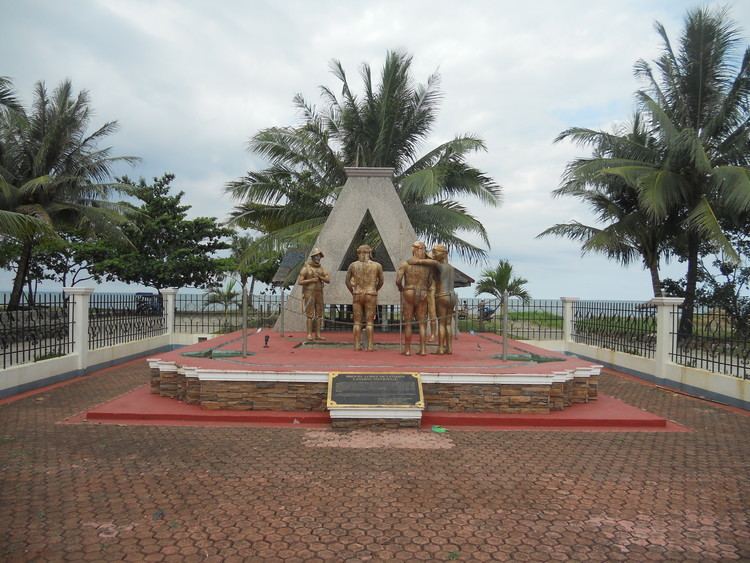Country Philippines Barangays Time zone PST (UTC+8) Province Leyte | District 5th district of Leyte Demonym(s) Abuyognon Area 688.2 km² Dialling code 53 | |
 | ||
Region Eastern Visayas (Region VIII) | ||
Sinulog 2016 street dancing champion tribu buyoganon abuyog leyte
Abuyog is a 1st class municipality in the province of Leyte, Philippines. According to the 2015 census, it has a population of 59,571 people.
Contents
- Sinulog 2016 street dancing champion tribu buyoganon abuyog leyte
- Map of Abuyog Leyte Philippines
- Featuring abuyog leyte
- Barangays
- History
- Daughter towns
- Places of interest
- Education
- Healthcare
- References
Map of Abuyog, Leyte, Philippines
Facing Leyte Gulf out into the Philippine Sea, it is the largest town of the island of Leyte in terms of land area. It is bordered to the north by Javier, to the east by Mahaplag and Baybay City and to the south by Silago in Southern Leyte.
Abuyog got its name when Spanish sailors came ashore in an early settlement at the mouth of the Abuyog River to replenish their supplies. Swarms of bees were all over the shore. The Spaniards asked the natives "Como si y llama el pueblo?", not knowing that the Spaniards asked for the town's name, the natives answered "Buyog". Repeating after the natives, the sailors muttered, "Ah! Buyog". Eventually the town came to be known as "Abuyog" to which some Spanish chroniclers often used in reference to the whole island of Leyte. But Abuyog in the early annals, though grown prosperous, remained obscure because of the absence of a powerful chieftain. It was Datu Bangcao, who had his seat of government in Carigara, who ruled Abuyog.
People mostly from Samar migrated to Abuyog because of the many opportunities the immigrants got from its rich soil. The language of this town which acquired the name "melting pot" became Waray-Waray language from the Samar immigrants.
Featuring abuyog leyte
Barangays
Abuyog is politically subdivided into 63 barangays.
History
In 1588, presumably on account of mal-administration of the incumbent encomendero, the inhabitants revolted. Capitan Juan Esguerra had to send a punitive force to chastise the assassins of the encomendero. In 1613, Sanguiles and Caragas plundered and marauded the town.
In 1655 the Jesuits made Abuyog their second post, with Dagami as the center. The year 1716 saw the founding of the town and parish under the patronage of St. Francis Xavier, the apostle of the Indies. The Augustinians took over in 1768 and continued the work of Frs. Jose Herrera and Cipriano Barbasan. The people of this era, according to Fr. Augustin Maria de Castro, were very rich though extremely belligerent; the continually defied the Moros. In 1843 the town was given to the Franciscan Order with Fr. Santiago Malonda as the first Franciscan parish priest. A horse path was opened between Abuyog and Dulag in 1851.
The early captains were Galza, Foran, Nicolas Mandia, Faustino Remanes, Prudencio Remanes, Felipe Costin, Ciriaco Costin, Eulalio Brillo, and Vicente Tiaoson. Eulalio Brillo became president in 1896-1899 while Nazario Tupa took office in 1900. Eugenio Villote finished Tupa's term.
The period 1901 to 1906 was notable for the notorious pulahanes or bolero attacks, the most infamous leader of which was Faustino Ablen. The municipal building was razed. Ex-Capitan Eugenio Villote, Pedro Gonazaga, and two other policemen were killed in the encounter.
In the electoral division made by the Philippine Assembly, Abuyog was placed in the third district of Leyte. During the Commonwealth regime, Abuyog was transferred to the fourth district. During these periods, the town prospered under the administration of Arturo Brillo, Vicente Brillante, Basilio Adolfo (two terms), Antero Brillo and Ricardo Collantes (three terms). In 1940, Pedro Gallego was elected mayor and served until July 3, 1946, Mayor Pedro Remanes Gallego was the only mayor in Leyte that did not surrender to the Japanese forces . On July 4, 1946, Catalino Landia was appointed mayor. He was re-elected for three terms.
Abuyog's progress took greater strides with the inauguration of the first passenger bus service in 1925. In 1936, the vice-president Sergio Osmeña inaugurated the Baybay-Abuyog road, thus linking for the first time, by good road, the eastern and western coasts of Leyte.
At the outbreak of World War II, Abuyog became a Japanese occupied area. But on October 13, 1942, the Japanese abandoned the town due to guerrilla pressure. They came back on November 26, 1943, much stronger this time, yet they suffered heavy losses in the hands of the guerrillas.
On July 14, 1944, the submarine "Nautilus" landed in Barangay San Roque to unload 72 tons of much-needed weapons and ammunition, food and propaganda materials for Leyte and Samar guerrillas. When the American Armada was sighted off Leyte Gulf, the Japanese forces deserted the town of Abuyog before the American landing and entered to the Filipino troops of the Philippine Commonwealth Army and Philippine Constabulary military units. After liberation, elementary school education was resumed on December 4, 1944 under the supervision of the Philippine Civil Affairs Unit (PCAU). From then on, Abuyog's development went on steadily under the consistent leadership of Mayor Catalino T. Landia.
Daughter towns
Javier used to be Baranggay Bugho, MacArthur used to be Baranggay Taraguna and Mahaplag used to be Baranggay Mahaplag.
